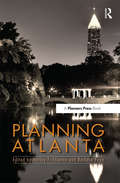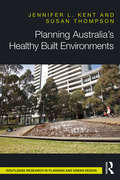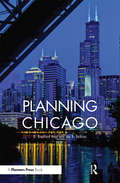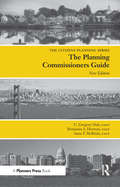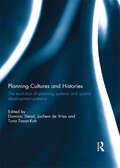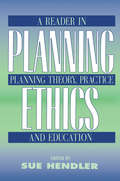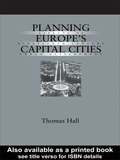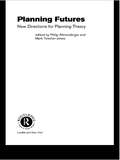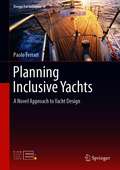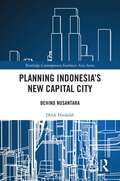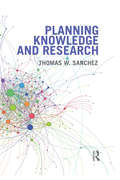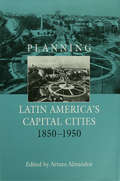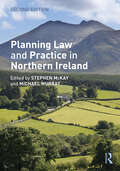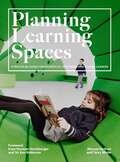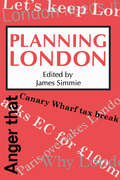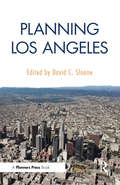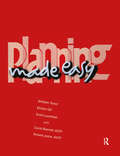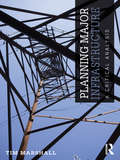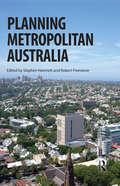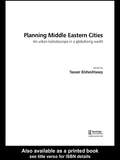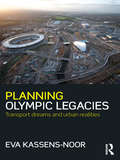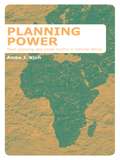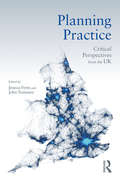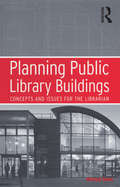- Table View
- List View
Planning Atlanta
by Harley F. Etienne Barbara FagaMore than any other major U.S. city, Atlanta regularly reinvents itself. From the Civil War’s devastation to the 1996 Olympic boom to the current housing crisis, the city’s history is a cycle of rise and fall, ruin and resurgence. In Planning Atlanta, two dozen planning practitioners and thought leaders bring the story to life. Together they trace the development of projects like Freedom Parkway and the Jimmy Carter Presidential Library. They examine the impacts of race relations on planning and policy. They explore Atlanta’s role as a 19th-century rail hub—and as the home of the world’s busiest airport. They probe the city’s economic and environmental growing pains. And they look toward new plans that will shape Atlanta’s next incarnation. Read Planning Atlanta and discover a city where change is always in the wind.
Planning Australia’s Healthy Built Environments
by Susan Thompson Jennifer L. KentPlanning Australia’s Healthy Built Environments shines a quintessentially Australian light on the links between land use planning and human health. A burgeoning body of empirical research demonstrates the ways urban structure and governance influences human health—and Australia is playing a pivotal role in developing understandings of the relationships between health and the built environment. This book takes a retrospective look at many of the challenges faced in pushing the healthy built environment agenda forward. It provides a clear and theoretically sound framework to inform this work into the future. With an emphasis on context and the pursuit of equity, Jennifer L. Kent and Susan Thompson supply specific ways to better incorporate idiosyncrasies of place and culture into urban planning interventions for health promotion. By chronicling the ways health and the built environment scholarship and practice can work together, Planning Australia’s Healthy Built Environments enters into new theoretical and practical debates in this critically important area of research. This book will resonate with both health and built environment scholars and practitioners working to create sustainable and health-supportive urban environments.
Planning Chicago
by D. Bradford Hunt Jon B DeVriesIn this volume the authors tell the real stories of the planners, politicians, and everyday people who shaped contemporary Chicago, starting in 1958, early in the Richard J. Daley era. Over the ensuing decades, planning did much to develop the Loop, protect Chicago’s famous lakefront, and encourage industrial growth and neighborhood development in the face of national trends that savaged other cities. But planning also failed some of Chicago’s communities and did too little for others. The Second City is no longer defined by its past and its myths but by the nature of its emerging postindustrial future. This volume looks beyond Burnham’s giant shadow to see the sprawl and scramble of a city always on the make. This isn’t the way other history books tell the story. But it’s the Chicago way.
Planning Commissioners Guide: Processes for Reasoning Together
by C Gregory Dale Benjamin A Herman Anne McBrideAcross the country, communities rely on their planning commissions for guidance. But who guides the planning commissioners? This step-by-step guidebook gets new commissioners off on the right foot and helps experienced commission members navigate their roles. The authors, all practicing planners, have worked extensively with planning commissions for decades. They have watched commissioners scramble up a steep learning curve, sit in the hot seat of controversy, and strive to make sound decisions for the places they call home. In this helpful handbook, the authors share ideas, insights, and information to help commissioners succeed. Eight detailed chapters cover everything from the nuts and bolts of development applications to the nuances of legal issues to the part commissioners play in long-range planning. Readers will learn how to prepare for their first commission meeting, review a development plan, invite productive public input, and steer clear of ethical dilemmas. Added resources include a glossary of planning terms, a list of training resources, and the American Planning Association’s Statement of Ethical Principles in Planning. For anyone serving on a planning commission, The Planning Commissioners Guide is essential reading.
Planning Cultures and Histories: The evolution of Planning Systems and Spatial Development Patterns
by Dominic Stead, Jochem de Vries and Tuna Tasan-KokThis book addresses the influences of planning cultures and histories on the temporal evolution of planning systems and spatial development. As well as providing an international comparative perspective on these issues, the contributions to the book also engage in a search for new conceptual frameworks and alternative points of view to better understand and explain these differences. The book makes three main academic contributions. First, it catalogues some of the key changes in planning systems and the impact on spatial development patterns. Second, it examines the interrelationship between planning cultures and histories from a path-dependency perspective. Third, it discusses the variations in physical development patterns resulting from different planning cultures and histories. Chapters from different parts of the European continent present evidence at different scales to illustrate these aspects. In all cases, the specific combinations of political, ideological, social, economic and technological factors are important determinants of urban and regional planning trajectories as well as spatial development patterns. This book was previously published as a special issue of European Planning Studies.
Planning Ethics
by Murray StrausOver the past fifty years professional understanding of planning has changed markedly. In the past, planning was primarily described as a technical activity involving data collection, analysis, and synthesis of physical plans and supporting policies. Now planning is seen as a much broader set of human activities, encompassing the physical world and also the realm of public and social services. Not surprisingly, planners' discussions of ethics have evolved. Professional ethics is regarded by many planners to be limited to a set of rules of behavior regarding interactions with the public, sources of data, government officials, and one another.This shift is symbolized by the evolution of the labels by which ethics is known: from a circumscribed view of professional ethics to a broader concept of ethics in planning; both of which are discussed in this book. Sue Hendler argues that planners recognize that every act of planning pursues certain human values and is a series of statements about what we take to be right or wrong and what we take to represent the highest priorities of the society.Planning Ethics explores planning within alternative moral theories, including liberalism, communitarianism, environmentalism, and feminism. The contributors illustrate the application of these ethical principles in specific planning contexts encompassing community development, land conversion, waste management, electric power planning, and education planning. This is the next generation of thinking on ethics and planning. It will be a centerpiece of every planning curriculum.
Planning Europe's Capital Cities: Aspects of Nineteenth-Century Urban Development (Planning, History and Environment Series)
by Thomas HallDuring the nineteenth century many of Europe's capital cities were subject to major expansion and improvement schemes. From Vienna's Ringstrasse to the boulevards of Paris, the townscapes which emerged still shape today's cities and are an inalienable part of European cultural heritage.In Planning Europe's Capital Cities, Thomas Hall examines the planning process in fifteen of those cities and addresses the following questions: when and why did planning begin, and what problems was it meant to solve? who developed the projects, and how, and who made the decisions? what urban ideas are expressed in the projects? what were the legal consequences of the plans, and how did they actually affect subsequent urban development in the individual cities? what similarities or differences can be identified between the various schemes? how have such schemes affected the development of urban planning in general?His detailed analysis shows us that the capital city projects of the nineteenth century were central to the evolution of modern planning and of far greater impact and importance than the urban theories and experiments of the Utopians.
Planning Futures: New Directions for Planning Theory
by Philip Allmendinger Mark Tewdwr-JonePlanning theory is currently in a confused state as a consequence of a number of changes over the last ten years in planning practice and social and economic theory. Even prior to these events, planning theory was an uncertain discipline, reflecting planning's precarious position between and resting upon a range of professional subject areas and philosophical roots. Planning Futures is an attempt to pin down the constantly evolving landscape of planning theory and to chart a path through this fast changing field.Planning Futures is an up-to-date reader on planning theory, but adds something more to the subject area than a mere textbook. The contributors have attempted to bridge theory and practice while putting forward new theoretical ideas. By drawing upon examples from planning practice and case study scenarios, the authors ensure that the work discusses planning theory within the context of present planning practice. Case studies are drawn from an international arena, from the UK, Europe, South Africa and Australia.
Planning Inclusive Yachts: A Novel Approach to Yacht Design (Design For Inclusion #1)
by Paolo FerrariThis book proposes a novel approach to the design of accessible and inclusive sailing yachts, inspired by the principles of “Design for All.” The goal is to allow anyone, including users with disabilities and individuals belonging to the weaker segments, to sail without barriers. Starting from an analysis of existing pleasure boats, the author identifies a series of factors limiting the accessibility or usability of external and internal spaces. In turn, he discusses the most suitable solutions to each. By proposing an extensive set of design solutions applicable to the confined spaces on yachts, and which comply with the relevant anthropometric and dimensional rules, the book offers a timely snapshot of the potential benefits and applicability of an inclusive approach to yacht design, setting a new reference standard for inclusive and accessible nautical design.
Planning Indonesia's New Capital City: Behind Nusantara (Routledge Contemporary Southeast Asia Series)
by Delik HudalahThis book critically analyzes the hidden political dimensions associated with the planning of Indonesia's new capital. Planning Indonesia’s New Capital City reveals the underlying agendas behind the Indonesian government’s decisive and rapid action, under the leadership of President Jokowi, to relocate the national capital amid precarious global political and economic conditions. The central argument posits that the capital relocation is politically justified, reflecting the president's ambitions for megaprojects and, to a significant extent, the interests of his governing coalitions. The desire to establish a political legacy has emerged as a primary hidden agenda that compels state leaders and their allies to pursue the ambitious initiative of moving the capital from Jakarta to Nusantara on Kalimantan Island. As a lasting monument and symbol of modernization and prosperity, the Capital City of Nusantara (IKN) aims to reflects the enduring influence of the builder-in-chief of the world’s third-largest democracy. The long-term viability of this capital city megaproject as a political legacy is contingent upon the effectiveness of formal, informal, and cultural institutional mechanisms both prior to and following the pivotal events of the 2024 presidential election and the subsequent transition of leadership. Addressing a significant gap in the literature and a timely contribution, this book will be of interest to researchers in the fields of human geography, Asian urban studies, Southeast Asian Studies and megaproject management.
Planning Knowledge and Research
by Thomas W. SanchezThe field of urban planning is far-reaching in breadth and depth. This is due to the complex nature of cities, regions, and development processes. The knowledge domain of planning includes social, economic, technological, environmental, and political systems that continue to evolve and expand rapidly. Understanding these systems is an inter-disciplinary endeavor at the scale of several academic fields. The wide range of topics considered by planning educators and practitioners are often based on varying definitions of "planning" and modes of planning practice. This unique book discusses various elements and contributions to urban planning research to show that seemingly disparate topics do in fact intersect and together, contribute to ways of understanding urban planning. The objective is not to discuss how to "do" research, but rather, to explore the context of urban planning scholarship with implications for the planning academy and planning practice. This edited volume includes chapters contributed by a diverse range of planning scholars who consider the corpus of planning scholarship both historically and critically in their area of expertise. It is essential reading for students of planning research and planning theory from around the world.
Planning Latin America's Capital Cities 1850-1950 (Planning, History And The Environment Ser.)
by Arturo AlmandozIn this first comprehensive work in English to describe the building of Latin America's capital cities in the postcolonial period, Arturo Almandoz and his contributors demonstrate how Europe and France in particular shaped their culture, architecture and planning until the United States began to play a part in the 1930s. The book provides a new per
Planning Law and Practice in Northern Ireland
by Stephen McKay and Michael MurrayEach of the jurisdictions within the United Kingdom is constantly refining the operational characteristics of its planning system and while there are some common practices, there are also substantive divergences. In each territory the planning template is shaped within a dynamic political and legal context and thus students and practitioners require an accessible, in-depth and up-to-date literature dealing with this matter. The multi-disciplinary contributors to this expanded Second Edition of Planning Law and Practice in Northern Ireland explore the progression of planning within the region and discuss prominent facets of contemporary development management, development plans, environmental law, property law and professional practice. Consideration is given to the consequences of Brexit for planning in Northern Ireland, devolved government institutional structures for planning, and the post-2015 emergent performance of local authorities in this arena. The book makes an important contribution to the wider literature in this field and, with its extensive citing of statutes and cases, provides an essential resource for students, planning practitioners and researchers.
Planning Learning Spaces
by Murray Hudson“A welcome and timely addition to the subject of school design at a time of great change.†—Professor Alan Jones, President of the Royal Institute of British Architects “Comprehensive but also very practical approach.†—Andreas Schleicher, Director for the Directorate of Education and Skills in Paris, France“Any community building a new school should read this book.†—Michael B. Horn, Clayton Christensen Institute for Disruptive Innovation in Boston, USA “Builds a bridge from the simple to the extraordinary... awash in opportunity and inspiration.†—Professor Stephen Heppell, Chair in Learning Innovation at the Universidad Camilo Jose Cela in Madrid, Spain Can school design help us to realize a new vision for education that equips young people for life in a fast-changing world? This is the big question at the heart of Planning Learning Spaces, a new guide for anyone involved in the planning and design of learning environments. Murray Hudson and Terry White have brought together educators and innovative school architects to pool their collective expertise and inspire the design of more intelligent learning spaces. The authors prompt readers to question common assumptions about how schools should look and how children should be educated: •Why have so many schools changed relatively little in more than a century? •What form should a school library take in the Internet age? •Do classrooms really have to be square?The book also tackles vital elements of learning space design such as the right lighting, heating and acoustics, and explores the key role of furniture, fixtures, and fittings.With contributions from leading professionals around the world, including Herman Hertzberger and Sir Ken Robinson, Planning Learning Spaces is an invaluable resource for architects, interior designers, and educators hoping that their project will make a genuine difference. Highly recommended reading for anyone involved with the process of building or updating an educational space.
Planning Learning Spaces: A Practical Guide for Architects, Designers, School Leaders
by Terry White Murray Hudson Murray Hudson, White“A welcome and timely addition to the subject of school design at a time of great change.”—Professor Alan Jones, President of the Royal Institute of British Architects “Comprehensive but also very practical approach.”—Andreas Schleicher, Director for the Directorate of Education and Skills in Paris, France“Any community building a new school should read this book.”—Michael B. Horn, Clayton Christensen Institute for Disruptive Innovation in Boston, USA “Builds a bridge from the simple to the extraordinary... awash in opportunity and inspiration.”—Professor Stephen Heppell, Chair in Learning Innovation at the Universidad Camilo Jose Cela in Madrid, Spain Can school design help us to realize a new vision for education that equips young people for life in a fast-changing world? This is the big question at the heart of Planning Learning Spaces, a new guide for anyone involved in the planning and design of learning environments. Murray Hudson and Terry White have brought together educators and innovative school architects to pool their collective expertise and inspire the design of more intelligent learning spaces. The authors prompt readers to question common assumptions about how schools should look and how children should be educated: • Why have so many schools changed relatively little in more than a century? • What form should a school library take in the Internet age? • Do classrooms really have to be square?The book also tackles vital elements of learning space design such as the right lighting, heating and acoustics, and explores the key role of furniture, fixtures, and fittings.With contributions from leading professionals around the world, including Herman Hertzberger and Sir Ken Robinson, Planning Learning Spaces is an invaluable resource for architects, interior designers, and educators hoping that their project will make a genuine difference. Highly recommended reading for anyone involved with the process of building or updating an educational space.
Planning London: The Case Of London (Progress In Planning Ser.)
by James SimmieAn introduction to the problems and practices of planning in London. The authors address the question of what contributions the land-use planning system has made and could make to resolving decrepit public transport, congestion, noise, dirt, crime, poverty, begging, homelessness. They analyse these conflicts in terms of history, jobs, housing, transport and the quality of the environment - and considers future options.
Planning Los Angeles: Artists And Communities Working Together (Routledge Research In Planning And Urban Design Ser.)
by David C. SloaneLos Angeles isn’t planned; it just happens. Right? Not so fast! Despite the city’s reputation for spontaneous evolution, a deliberate planning process shapes the way Los Angeles looks and lives. Editor David C. Sloane, a planning professor at the University of Southern California, has enlisted 30 essayists for a lively, richly illustrated view of this vibrant metropolis. Planning Los Angeles launches a new series from APA Planners Press. Each year Planners Press will bring out a new study on a major American city. Natives, newcomers, and out-of-towners will get insiders’ views of today’s hot-button issues and a sneak peek at the city to come.
Planning Made Easy
by Carol Barrett William Toner Efraim Gil Enid Lucchesi Robert JoiceDeveloping a program to train planning commissioners and zoning board members takes a lot of time and effort. This manual makes the process easier. It covers the basics of community planning, zoning, subdivision regulation, and ethics. With chapters organized in discrete modules, it's ideal for both self-study and classroom use. Narratives explain general planning principles. Exercises encourage users to think about the planning issues in their communities. And worksheets reinforce important concepts. A complementary training guide, Training Made Easy, is also available. Planning Made Easy is published as looseleaf pages in a three-ring notebook.
Planning Major Infrastructure: A Critical Analysis
by Tim MarshallThis book analyses the planning and policy world of major infrastructure as it is moving now in Europe and the UK. Have some countries managed to generate genuine consensus on how the large changes are progressed? What can we learn from the different ways countries manage these challenges, to inform better spatial planning and more intelligent political steering? Case studies of the key features of policy and planning approaches in France, Germany, the Netherlands, Spain and the UK are at the core of Planning Major Infrastructure. This includes the different regimes introduced in England and Wales, and Scotland, brought in by reforms since 2006. High speed rail, renewable energy deployment, water management, waste treatment – all raise critical planning issues. The case studies connect to the big issues of principle which haunt this field of public policy: how can democratic legitimacy be secured? How can ecological and economic transitions be managed? What is the appropriate role of the national government in each of these areas, as against other levels? What part has the EU played, and should it be involved in the future? These are some of the central themes raised in this innovating exploration of this currently high profile field.
Planning Metropolitan Australia (Planning, History and Environment Series)
by Robert Freestone Stephen HamnettAustralia has long been a highly (sub)urbanized nation, but the major distinctive feature of its contemporary settlement pattern is that the great majority of Australians live in a small number of large metropolitan areas focused on the state capital cities. The development and application of effective urban policy at a regional scale is a significant global challenge given the complexities of urban space and governance. Building on the editors’ previous collection The Australian Metropolis: A Planning History (2000), this new book examines the recent history of metropolitan planning in Australia since the beginning of the twenty-first century. After a historical prelude, the book is structured around a series of six case studies of metropolitan Melbourne, Sydney, Adelaide, Perth, the fast-growing metropolitan region of South-East Queensland centred on Brisbane, and the national capital of Canberra. These essays are contributed by some of Australia’s leading urbanists. Set against a dynamic background of economic change, restructured land uses, a more diverse population, and growing spatial and social inequality, the book identifies a broad planning consensus around the notion of making Australian cities more contained, compact and resilient. But it also observes a continuing gulf between the simplified aims of metropolitan strategies and our growing understanding of the complex functioning of the varied communities in which most people live. This book reflects on the raft of planning challenges presented at the metropolitan scale, looks at what the future of Australian cities might be, and speculates about the prospects of more effective metropolitan planning arrangements.
Planning Middle Eastern Cities: An Urban Kaleidoscope (Planning, History and Environment Series)
by Yasser ElsheshtawyMiddle Eastern cities cannot be lumped together as a single group. Rather they make up the urban kaleidoscope of the title, as the diversity of the six cities included here shows. They range from cities rich in tradition (Cairo, Tunis, and Baghdad), to neglected cities (Algiers and Sana'a), to newly emerging 'oil-rich' Gulf cities (Dubai). The authors are all young Arab scholars and architects local to the cities they describe, providing an authentic voice with an understanding no outsider could achieve. These contributors move away from an exclusively 'Islamic' reading of Arab cities - which they regard as outdated and counterproductive. Instead, they explore issues of identity and globalization in the context of the struggles and solutions offered by each city from the late nineteenth century to the present day. Their focus is on how the built environment has changed over time and under different influences.
Planning Olympic Legacies: Transport Dreams and Urban Realities
by Eva Kassens-NoorWhen a city wins the right to hold the Olympics, one of the oft cited advantages to the region is the catalytic effect upon the urban and transport projects of the host cities. However, with unparalleled access to documents and records, Eva Kassens-Noor questions and challenges this fundamental assertion of host cities who claim to have used the Olympic Games as a way to move forward their urban agendas In fact, transport dreams to stage the "perfect games" of the International Olympic Committee and the governments of the host cities have lead to urban realities that significantly differ from the development path the city had set out to accomplish before winning the Olympic bid. Ultimately it is precisely the IOC’s influence – and the city’s foresight and sophistication (or lack thereof) in coping with it – that determines whether years after the Games there are legacies benefitting the former hosts. The text is supported by revealing interviews from lead host city planners and key documents, which highlight striking discrepancies between media broadcasts and the internal communications between the IOC and host city governments. It focuses on the inside story of the urban and transport change process undergone by four cities (Barcelona, Atlanta, Sydney, and Athens) that staged the Olympics and forecasts London and Rio de Janeiro’s urban trajectories. The final chapter advises cities on how to leverage the Olympic opportunity to advance their long-run urban strategic plans and interests while fulfilling the International Olympic Committee’s fundamental requirements. This is a uniquely positioned look at why Olympic cities have – or do not have – the transport and urban legacies they had wished for. The book will be of interest to planners, government agencies and those involved in organizing future Games.
Planning Power: Town Planning and Social Control in Colonial Africa
by Ambe NjohWith a multidisciplinary perspective, Planning Power examines British and French colonial town and country planning efforts in Africa. Drawing out similarities in the colonial administrative and economic strategies of the two powers, rather than emphasizing the differences, the book offers an unusually nuanced view of African planning systems in a time of upheaval and political change. In showing how the colonial authorities sought to gain political and social control in Africa, it can be seen how their will to exert political power influenced every area of planning practice during this era. This unique comparative analysis of British and French colonial town planning – covering the entire sub-Saharan African region – takes theories from a wide range of disciplines, including political science, history, urban and regional planning, economics and geography to paint a comprehensive picture of the subject. Written by a prolific researcher and writer in the political-economy of urban and regional planning in Africa, Planning Power is valuable reading for students and academics in a range of disciplines.
Planning Practice: Critical Perspectives from the UK
by John Tomaney Jessica FermPlanning Practice: Critical Perspectives from the UK provides the only comprehensive overview of contemporary planning practice in the UK. Drawing on contributions from leading researchers in the field, it examines the tools, contexts and outcomes of planning practice. Part I examines planning processes and tools, and the extent to which theory and practice diverge, covering plan-making, Development Management, planning gain, public engagement and place-making. Part II examines the changing contexts within which planning practice takes place, including privatisation and deregulation, devolution and multi-level governance, increased ethnic and social diversity, growing environmental concerns and the changing nature of commercial real estate. Part III focuses on how planning practice produces outcomes for the built environment in relation to housing, infrastructure, economic progress, public transport and regeneration. The book considers what it means to be a reflective practitioner in the modern planning system, the constraints and opportunities that planners face in their daily work, and the ethical and political challenges they must confront.
Planning Public Library Buildings: Concepts and Issues for the Librarian
by Michael DewePlanning a new or refurbished public library means considering not only facilities for collections, services, staff and users, but examining also the local context, reviewing the library image, and developing relationships with other community facilities and agencies. This book examines the entire gamut of challenges confronting the planning and development of contemporary public libraries; their mission, their roles, and key issues such as lifelong learning, social inclusion, community and cultural needs, regeneration and funding. The helpful presentation and readable style guides the librarian through the preliminary information-gathering and decision-making process that ensures a successful library building for all concerned. Using practical case studies, plans and photographs, the author tackles the critical issues of siting, size, plans and design concepts, and provides a helpful guide to weighing up the alternatives of refurbished, converted and new buildings. Separate chapters focus on the planning, briefing and construction process; security, safety and sustainability; key characteristics of successful buildings; identity, decor and signage; and interior layout and facilities. The text draws together a vast resource of real library examples from all over the world which provide best practice models and lessons to learn. For funding authorities, librarians and architects of public libraries this is a highly informative book that will help to ensure wise decision-making and prevent costly mistakes.
